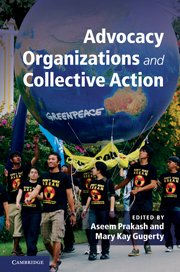Book contents
- Frontmatter
- Contents
- Figures and tables
- Contributors
- Preface
- Acknowledgments
- 1 Advocacy organizations and collective action
- Part 1 The institutional environment and advocacy organizations
- Part 2 Advocacy tactics and strategies
- 5 The market for human rights
- 6 Brand identity and the tactical repertoires of advocacy organizations
- 7 Shopping around
- Part 3 International advocacy and market structures
- Part 4 Toward a new research program
- Index
- References
6 - Brand identity and the tactical repertoires of advocacy organizations
Published online by Cambridge University Press: 05 June 2012
- Frontmatter
- Contents
- Figures and tables
- Contributors
- Preface
- Acknowledgments
- 1 Advocacy organizations and collective action
- Part 1 The institutional environment and advocacy organizations
- Part 2 Advocacy tactics and strategies
- 5 The market for human rights
- 6 Brand identity and the tactical repertoires of advocacy organizations
- 7 Shopping around
- Part 3 International advocacy and market structures
- Part 4 Toward a new research program
- Index
- References
Summary
In a recent study examining perceptions of nonprofit organizations, Venable et al. found that “across nonprofit classifications (health, environment/rights, and arts/humanities), there are distinct personality differences” (2005: 308). Respondents were able to discern differences among organizations with respect to qualities such as integrity, nurturance, sophistication, and ruggedness. For example, the perception of Greenpeace’s integrity was low compared to other nonprofits studied (Venable et al., 2005: 304). What factors drive respondents to such conclusions? In this chapter, I argue that how interest organizations go about their work – the tactical choices they make – represents an important component of their brand identity. Explaining public impressions of Greenpeace becomes more straightforward when we consider the organization’s repertoires of contention. Arguably, Greenpeace’s tactics, which tend to garner media attention, raise concerns among the public that the organization behaves unfairly with respect to its targets (Japanese whalers, for example). Nevertheless, while many may disapprove of Greenpeace’s methods of operation, those techniques clearly appeal to its resource base. Furthermore, the group’s distinct tactical repertoire also allows it to operate within its own niche in the environmental policy sector.
In her book The Populist Paradox: Interest Group Influence and the Promise of Direct Legislation, Elisabeth R. Gerber (1999) argues that the behavior of advocacy organizations is analogous to that of firms. Advocacy groups weigh the costs and benefits of proposed actions just as firms do. Both firms and groups seek to maintain themselves and to reap profits. For firms, profits are monetary, whereas for groups, profits take the form of policy successes. In this volume, several authors are guided by the firm analogy: McGee Young understands the organizational development of the Natural Resources Defense Council by grounding the group in a competitive market, for example. And as Clifford Bob notes in his analysis of human rights organizations, the policy choices human rights groups make are, like the choices of firms, a function of their particular niche in a larger “market.”
- Type
- Chapter
- Information
- Advocacy Organizations and Collective Action , pp. 155 - 176Publisher: Cambridge University PressPrint publication year: 2010
References
- 12
- Cited by



